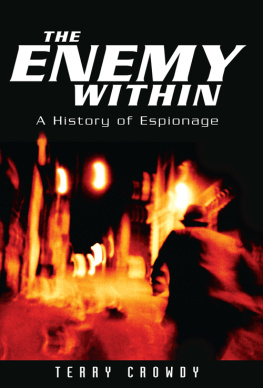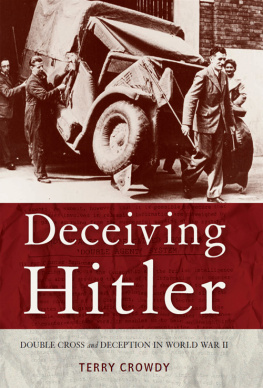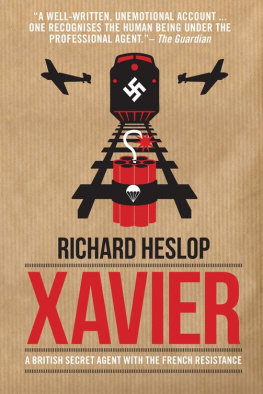Terry Crowdy - The Enemy Within: A History of Espionage
Here you can read online Terry Crowdy - The Enemy Within: A History of Espionage full text of the book (entire story) in english for free. Download pdf and epub, get meaning, cover and reviews about this ebook. year: 2008, publisher: Osprey Publishing, genre: Art. Description of the work, (preface) as well as reviews are available. Best literature library LitArk.com created for fans of good reading and offers a wide selection of genres:
Romance novel
Science fiction
Adventure
Detective
Science
History
Home and family
Prose
Art
Politics
Computer
Non-fiction
Religion
Business
Children
Humor
Choose a favorite category and find really read worthwhile books. Enjoy immersion in the world of imagination, feel the emotions of the characters or learn something new for yourself, make an fascinating discovery.
- Book:The Enemy Within: A History of Espionage
- Author:
- Publisher:Osprey Publishing
- Genre:
- Year:2008
- Rating:5 / 5
- Favourites:Add to favourites
- Your mark:
The Enemy Within: A History of Espionage: summary, description and annotation
We offer to read an annotation, description, summary or preface (depends on what the author of the book "The Enemy Within: A History of Espionage" wrote himself). If you haven't found the necessary information about the book — write in the comments, we will try to find it.
To gain the upper hand in conflict the ability to know what your enemy is planning is vital. Massive amounts of money have been spent and many lives have been lost in pursuit of this objective. From biblical times to the present day, leaders have employed espionage on and off the battlefield in the quest for victory. Tactics might differ, from dirty tricks and theft to interrogation and torture, but the aim is the same - to outmaneuver your enemy and emerge triumphant. Separating myth from reality, Terry Crowdy traces the history of espionage from its development in ancient times through to the end of the Cold War and into the 21st century, shedding light on the clandestine activities that have so often tipped the balance in times of war. His lively narrative delves into the murky depths of the realm of the spymasters and their spies, revealing many amazing, and often bizarre stories, along the way. From the slave with the tattoed head in Ancient Greece, through the ships monkey hanged as a spy during the Napoleonic wars to the British Double Cross ruse in World War II, and from Ivan the Terribles forming of the first Russian secret police in the 16th century through sexual wiles of Mata Hari to operations in the 21st century Middle East, this entertaining true history of espionage is as exciting as any spy fiction.
Chapter Heads - In ancient times. Through dark ages. Spy, Britannia! Espionage in the Age of Reason. Vive la revolution! Napoleons secret part. Uncivil war. The godfather of secret service. Spy fever. Double-cross agents and radio games. Axis spies against America. Spies of the Soviet era. With no end in sight.
Crowdys effective, readable summary of espionage in human history begins with the ancient Egyptians and doesnt end even with the Mossad. Throughout history, a broad range of not only governments but also people have used various means to learn about their enemies and, not infrequently, their friends. Although the senses of humans on the ground have always been highly valued, technology, including invisible inks and coding devices, also has a long history in spying. Women have figured prominently as spies (e.g., Delilah catching Samson in an early honey trap of sexual favors) and spymasters (e.g., Roman empress Theodora discouraging gossip about her colorful past). The growth of surveillance technology from miniature cameras to wiretaps and satellites has left the purely human instruments of intelligence gathering at a disadvantage in fights for appropriations and publicity, a situation that Crowdy deplores: A spy is like a traveling salesman--he has to know the territory. Readers of this book will know it, too, much better than they did before. Booklist
Terry Crowdy: author's other books
Who wrote The Enemy Within: A History of Espionage? Find out the surname, the name of the author of the book and a list of all author's works by series.












